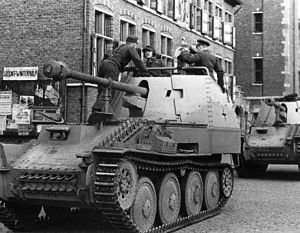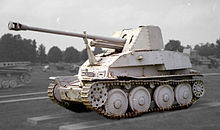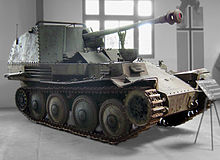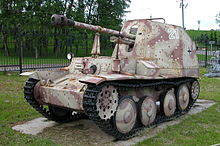- Marder III
-
Marder III 
Marder III Ausf.MType Tank destroyer Place of origin  Nazi Germany
Nazi GermanyService history In service 1942 to 1945 Used by Nazi Germany Wars World War II Production history Designed 1942 Produced 1942 to 1944 Specifications Weight 10,670 kg (23,523 lbs) Length 4.65 m (15 ft 3 in) Width 2.35 m (7 ft 9 in) Height 2.48 m (8 ft 2 in) Crew 4 Armor 10 - 50 mm Main
armament7.62 cm PaK 36(r) or 7.5 cm PaK 40 Secondary
armamentMG 34 or MG 42 Engine Praga Typ TNHPS/II water-cooled, 6-cylinder gasoline
125 PS (123.3 hp, 91.9 kW)Suspension leaf spring Ground clearance 40 cm (1 ft 4 in) The Marder III is the name for a series of World War II German tank destroyers built on the chassis of the Panzer 38(t). The German word Marder means "marten" in English. They were in production from 1942 to 1944 and served on all fronts until the end of the war.
Contents
History
Even in the early stages of Operation Barbarossa, the Wehrmacht already felt the need for a more mobile and more powerful anti-tank solution than the existing towed anti-tank guns such as Pak 36 or tank destroyers like the Panzerjäger I. This need became urgent in June 1941, when anti-tank shells failed to penetrate the armour of new Soviet tanks like the T-34 and KV-1.
As an interim solution, it was decided to use captured French vehicles like the Lorraine (Marder I), obsolete tanks such as German Panzer II (Marder II), and Czech-supplied 38(t) (Marder III) as the base for makeshift tank destroyers. The result was the Marder series, which were armed with either captured Soviet 76.2mm F-22 Model 1936 divisional field guns, or 75 mm PaK 40 anti-tank guns for later versions. Due to weight and space constraints of these small chassis, Marder series were not fully armored. Weak armor protection was provided only for the front and sides. All Marder series had open tops. Some were issued with canvas tops to protect the crew from the elements.
Development
 Marder III (Sd.Kfz.139) on display at the US Army Ordnance Museum in Aberdeen
Marder III (Sd.Kfz.139) on display at the US Army Ordnance Museum in Aberdeen
 Marder III Ausf.H (Sd.Kfz.138) on display at the Sinsheim Auto & Technik Museum in Germany
Marder III Ausf.H (Sd.Kfz.138) on display at the Sinsheim Auto & Technik Museum in Germany
 Marder III Ausf.M on display at the Musée des Blindés at Saumur
Marder III Ausf.M on display at the Musée des Blindés at Saumur
Marder III, Sd.Kfz. 139
While the Panzer 38(t) had largely become obsolete as a tank in early 1942, it was still an excellent platform for adaptation into a tank destroyer, among other roles. Since the Soviet 76.2 mm field gun was captured in large quantities, the decision was made to mate this gun to the Panzer 38(t).
To do so, the turret and upper superstructure of the Panzer 38 were removed and a new superstructure was bolted on to the chassis. The upper structure mounted the gun and an extended gun shield, giving very limited protection for the commander and the loader. Armour protection overall ranged from 10 to 50 mm. The gun, commander and loader were located on top of the engine deck. It had higher silhouette than Panzer 38, which made it more vulnerable to enemy fire.
The now-called 7.62 cm PaK 36(r) was rechambered to be able to use standard German 75 mm ammunition,[citation needed] of which 30 rounds could be carried inside the vehicle. Apart from the main gun, there was a 7.92 mm machine gun mounted in the hull.
This tank destroyer was put into production as the Panzerjäger 38(t) für 7.62 cm PaK 36(r), Sd.Kfz. 139. A total of 363 of this Marder III variant were built from April 1942 to 1943.
Marder III Ausf.H, Sd.Kfz. 138
The next variant of the Marder III fielded the standard 7.5 cm PaK 40 German anti-tank gun on the Panzer 38(t) Ausf. H. This had the engine in the rear of the vehicle (Ausf. H standing for Heckmotor (rear engine), same as Panzer 38. Unlike the previous model, however, this vehicle utilized the fighting compartment of Panzer 38 in the center. Center compartment allowed crew to stay low in the center of the vehicle, lowering crew exposure to small arms fire and fragments. But because of the rear-mounted engine, there was only enough room for two men to stand in the center. Large side armors gave additional protection for the crew. However, the horseshoe shape armor thinly protected front and side only. The rear and the top were exposed. Thirty-eight rounds of ammunition for the gun were carried. As with the Sd.Kfz.139, this vehicle also carried a 7.92 mm machine gun in the hull, of Czech manufacture.
The full name of this variant was the 7.5 cm PaK 40/3 auf Panzerkampfwagen 38(t) Ausf.H, Sd.Kfz. 138. The production figures for the 418 Ausf. H Marder IIIs are as follows; 243 (including a single prototype) were built new from November 1942 to April 1943. 175 were converted from Panzer 38(t)s in 1943.
Marder III Ausf.M, Sd.Kfz. 138
The last Marder III variant was based on the Panzer 38(t) Ausf. M (with Ausf. M standing for Mittelmotor (middle engine), again armed with the 75 mm PaK 40 anti-tank gun. In this variant, the engine was moved from the rear to the middle between driver and the rest of the crew. Because there was no engine in the rear, the gun and the crew did not have to sit on top of the engine deck as in previous models. The fighting compartment could be lowered down to the bottom floor level where the engine used to be. This decreased crew exposure, as well as visibility. Unlike the previous two Marder IIIs, the fighting compartment was closed at the rear protecting the crew up to their mid-section. It stayed open-topped. It could only carry 27 rounds of ammunition. The machinegun port at the front was eliminated in the Ausf. M in favor of an MG 34 or MG 42 carried by the crew. In the previous two models, the commander served as a gunner. However, in Ausf. M, the radio man moved to the rear with the commander and gunner, serving as a loader. Combat effectiveness increased because the vehicle commander was freed from manning the gun.
The Ausf. M was the variant which was produced in the largest numbers, some 975 vehicles being manufactured in 1943 and early 1944. Its full name was the Panzerjäger 38(t) mit 7.5 cm PaK 40/3 Ausf.M, Sd.Kfz. 138.
Combat history
 The Marder III Ausf. H on the Eastern Front.
The Marder III Ausf. H on the Eastern Front.
The various Marder IIIs fought on all fronts of the war, with the Sd.Kfz. 139 being used mainly at the Eastern Front, though some also fought in Tunisia. Even in February 1945 some 350 Ausf M were still in service.
The Marder IIIs were used by the Panzerjäger Abteilungen of the Panzer divisions of both the Wehrmacht and the Waffen SS, as well as several Luftwaffe units, like the Hermann Göring division.
The Marders were mechanically reliable, as with all vehicles based on the Czechoslovak 38t chassis. Their firepower was sufficient to destroy the majority of Soviet tanks on the battlefield at combat range.
The Marder's weaknesses were mainly related to survivability. The combination of a high silhouette and open-top armor protection made them vulnerable to indirect artillery fire. The armor was also quite thin, making them highly vulnerable to enemy tanks and to close-range machinegun fire.
The Marders were not assault vehicles or tank substitutes; the open top meant that operations in urban areas or other close-combat situations were very risky. They were best employed in defensive or overwatch roles. Despite their mobility they did not replace the towed antitank guns.
In March 1942, before Marder III appeared, Germany already started production of StuG III assault gun with comparable anti-tank capability (StuG III Ausf. F and later variants). These were fully armored vehicles, built in much greater numbers than vulnerable Marder III. Among many German fully armored tank destroyers, also one based on Panzer 38(t) chassis was built in numbers since 1944: the Jagdpanzer 38(t) (known as Hetzer). The weakly armored Marder series were phased out of production, however, they served until the end of the conflict.
External links
- Achtung Panzer!
- OnWar (Marder III, Sd.Kfz.139, (Marder III, Ausf.M, Sd.Kfz.138
- World War II vehicles
- Captured German vehicles - A PDF file presenting the German vehicles based on captured and modified foreign equipment (PzKpfw. 35(t), PzKpfw 38(t), 10.5 cm leFH 18(Sf) auf Geschützwagen, Marder I, Panzerjäger I, Marder III, Grille, Munitionspanzer 38(t)) still existing in the world
Tanks Panzer I · Panzer II · Panzer III · Panzer IV · Panther · Tiger I · Tiger II · Panzer 35(t) · Panzer 38(t)Self-propelled artillery Assault guns Tank destroyers Panzerjäger I · Marder I , II , III · RSO/PaK 40 · Nashorn · Elefant · Jagdpanzer IV · Hetzer · Jagdpanther · JagdtigerHalf-tracks Armored cars Self-propelled anti-aircraft guns Prototypes Panzer VIII Maus · E- series · Panther II · Heuschrecke 10 · Neubaufahrzeug · Sturer Emil · 10.5 cm K (gp.Sfl.) · Pz.Sfl. II · Flakpanzer Coelian · KugelpanzerProposed designs Categories:- World War II tank destroyers of Germany
Wikimedia Foundation. 2010.

